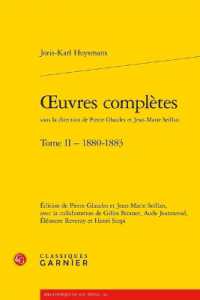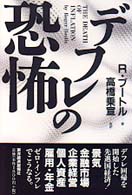- ホーム
- > 洋書
- > 英文書
- > Science / Mathematics
Full Description
Developments in power electronics and digital control have made the rugged, low-cost, high-performance induction machine the popular choice of electric generator/motor in many industries. As the induction machine proves to be an efficient power solution for the flexible, distributed systems of the near future, the dynamic worldwide market continues to grow. It is imperative that engineers have a solid grasp of the complex issues of analysis and design associated with these devices.The Induction Machines Design Handbook, Second Edition satisfies this need, providing a comprehensive, self-contained, and up-to-date reference on single- and three-phase induction machines in constant and variable speed applications. Picking up where the first edition left off, this book taps into the authors' considerable field experience to fortify and summarize the rich existing literature on the subject. Without drastically changing the effective logical structure and content of the original text, this second edition acknowledges notable theoretical and practical developments in the field that have occurred during the eight years since the first publication. It makes corrections and/or improvements to text, formulae, and figures. New material includes:Introduction of more realistic specifications and reworked numerical calculations in some of the examples Changes in terminologyDiscussion of some novel issues, with illustrative results from recent literatureNew and updated photosData on new mild magnetic materials (metglass)An industrial "sinusoidal" two-phase windingIllustrations of finite element method airgap flux densityEnhanced presentations of unbalanced voltage and new harmonic-rich voltage supply IM performanceDiscussion of stator (multiconductor) winding skin effect by finite element method Broad coverage of induction machines includes applications, principles and topologies, and materials, with numerical examples, analysis of transient behavior waveforms and digital simulations, and design sample cases. The authors address both standard and new subjects of induction machines in a way that will be both practically useful and inspirational for the future endeavors of professionals and students alike.
Contents
Induction MachinesElectric energy and induction motorsA historical touchInduction machines in applicationsConstruction Aspects and Operation PrinciplesConstruction aspects of rotary IMsConstruction aspects of linear induction motorsOperation principles of IMsMagnetic, Electric, and Insulation Materials for IMSoft magnetic materialsCore (magnetic) lossesElectrical conductorsInsulation materialsInduction Machine Windings and Their MMFsThe ideal traveling mmf of a.c. windingsA primitive single-layer windingA primitive two-layer chorded windingThe mmf harmonics for integer qRules for designing practical a.c. windingsBasic fractional q three-phase a.c. windingsBasic pole-changing three-phase a.c. windingsTwo-phase a.c. windingsPole-changing with single-phase supply induction motorsSpecial topics on a.c. windingsThe mmf of rotor windingsThe "skewing" mmf conceptThe Magnetization Curve and InductanceEquivalent airgap to account for slottingEffective stack lengthThe basic magnetization curveThe emf in an a.c. windingThe magnetization inductanceLeakage Inductances and ResistancesLeakage fieldsDifferential leakage inductancesRectangular slot leakage inductance/single layerRectangular slot leakage inductance/two layersRounded shape slot leakage inductance/two layersZig-zag airgap leakage inductancesEnd-connection leakage inductanceSkewing leakage inductanceRotor bar and end ring equivalent leakage inductanceBasic phase resistanceThe cage rotor resistanceSimplified leakage saturation correctionsReducing the rotor to statorSteady-State Equivalent Circuit and PerformanceBasic steady-state equivalent circuitClassification of operation modesIdeal no-load operationShort-circuit (zero speed) operationNo-load motor operationThe motor mode of operationGenerating to power gridAutonomous induction generator modeThe electromagnetic torqueEfficiency and power factorPhasor diagrams: Standard and newAlternative equivalent circuitsUnbalanced supply voltagesOne stator phase is openUnbalanced rotor windingsOne rotor phase is openWhen voltage varies around rated valueWhen stator voltage have time harmonicsStarting and Speed Control MethodsStarting of cage-rotor induction motorsStarting of wound-rotor induction motorsSpeed control methods for cage-rotor induction motorsVariable frequency methodsSpeed control methods for wound rotor IMsSkin and On-Load Saturation EffectsThe skin effectSkin effects by the multilayer approachSkin effect in the end rings via the multilayer approachThe double cage behaves like a deep bar cageLeakage flux path saturation-a simplified approachLeakage saturation and skin effects-a comprehensive analytical approachThe FEM approachStandardized line-start induction motorsAirgap Field Space Harmonics, Parasitic Torques, Radial Forces, and NoiseStator mmf produced airgap flux harmonicsAirgap field of a squirrel cage windingAirgap conductance harmonicsLeakage saturation influence on airgap conductanceMain flux saturation influence on airgap conductanceThe harmonics-rich airgap flux densityThe eccentricity influence on airgap magnetic conductanceInteractions of mmf (or step) harmonics and airgap magnetic conductance harmonics Parasitic torquesRadial forces and electromagnetic noiseLosses in Induction MachinesLoss classificationsFundamental electromagnetic lossesNo-load space harmonics (stray no-load) losses in nonskewed IMsLoad space harmonics (stray load) losses in nonskewed IMsFlux pulsation (stray) losses in skewed insulated barsInterbar current losses in uninsulated skewed rotor cagesNo-load rotor skewed uninsulated cage lossesLoad rotor skewed uninsulated cage lossesRules to reduce full load stray (space harmonics) lossesHigh frequency time harmonics lossesComputation of time harmonics conductor lossesTime harmonics interbar rotor current lossesComputation of time harmonic core lossesThermal Modeling and CoolingSome air cooling methods for IMsConduction heat transferConvection heat transferHeat transfer by radiationHeat transport (thermal transients) in a homogenous bodyInduction motor thermal transients at stallIntermittent operationTemperature rise (TON) and fall (TOFF) timesMore realistic thermal equivalent circuits for IMsA detailed thermal equivalent circuit for transientsThermal equivalent circuit identificationThermal analysis through FEMInduction Machine TransientsThe phase coordinate modelThe complex variable model Steady state by the complex variable modelEquivalent circuits for drivesElectrical transients with flux linkages as variablesIncluding magnetic saturation in the space phasor modelSaturation and core loss inclusion into the state-space modelReduced order modelsThe sudden short-circuit at terminalsMost severe transients (so far)The abc-dq model for PWM inverter fed IMsFirst order models of IMs for steady-state stability in power systemsMultimachine transientsSubsynchronous resonance (SSR)The m/Nr actual winding modeling for transientsMotor Specifications and Design PrinciplesTypical load shaft torque/speed envelopesDerating due to voltage time harmonicsVoltage and frequency variationSpecifying induction motors for constant V and f Matching IMs to variable speed/torque loadsDesign factorsDesign featuresThe output coefficient design conceptThe rotor tangential stress design conceptIM Design Below 100KW and Constant V and f (Size Your Own IM)Design specifications by exampleThe algorithmMain dimensions of stator coreThe stator windingStator slot sizingRotor slotsThe magnetization currentResistances and inductancesLosses and efficiencyOperation characteristicsTemperature riseIM Design Above 100KW and Constant V and f (Size Your Own IM)High voltage stator designLow voltage stator designDeep bar cage rotor designDouble cage rotor designWound rotor designIM with wound rotor-performance computationInduction Machine Design for Variable SpeedPower and voltage deratingReducing the skin effect in windingsTorque pulsations reductionIncreasing efficiencyIncreasing the breakdown torqueWide constant power speed range via voltage managementDesign for high and super-high speed applicationsSample design approach for wide constant power speed rangeOptimization DesignEssential optimization design methodsThe augmented Lagrangian multiplier method (ALMM)Sequential unconstrained minimizationA modified Hooke-Jeeves methodGenetic algorithmsThree Phase Induction GeneratorsSelf-excited induction generator (SEIG) modelingSteady state performance of SEIGThe second order slip equation model for steady stateSteady state characteristics of SEIG for given speed and capacitorParameter sensitivity in SEIG analysisPole changing SEIGsUnbalanced steady state operation of SEIGTransient operation of SEIGSEIG transients with induction motor loadParallel operation of SEIGsThe doubly-fed IG connected to the gridLinear Induction GeneratorsClassifications and basic topologiesPrimary windingsTransverse edge effect in double-sided LIMTransverse edge effect in single-sided LIMA technical theory of LIM longitudinal end effectsLongitudinal end-effect waves and consequencesSecondary power factor and efficiencyThe optimum goodness factorLinear flat induction actuators (no longitudinal end-effect)Tubular LIAsShort-secondary double-sided LIAsLinear induction motors for urban transportationTransients and control of LIMsElectromagnetic induction launchersSuper-High Frequency Models and Behavior of IMsThree high frequency operation impedancesThe differential impedanceNeutral and common mode impedance modelsThe super-high frequency distributed equivalent circuitBearing currents caused by PWM invertersWays to reduce PWM inverter bearing currentsTesting of Three-Phase IMsLoss segregation testsEfficiency measurementsThe temperature-rise test via forward short-circuit (FSC) methodParameter estimation testsNoise and vibration measurements: from no-load to loadSingle-Phase Induction Machines: The BasicsSplit-phase induction motorsCapacitor induction motorsThe nature of stator-produced airgap fieldThe fundamental mmf and its elliptic waveForward-backward mmf wavesThe symmetrical components general modelThe d-q modelThe d-q model of star Steinmetz connectionSingle-Phase Induction Motors: Steady StateSteady state performance with open auxiliary windingThe split-phase and the capacitor IM: currents and torqueSymmetrization conditionsStarting torque and current inquiresTypical motor characteristicNonorthogonal stator windingsSymmetrization conditions for nonorthogonal windingsMmf space harmonic parasitic torquesTorque pulsationsInter-bar rotor currentsVoltage harmonics effectsThe doubly tapped winding capacitor IM Single-Phase IM TransientsThe d-q model performance in stator coordinatesStarting transientsThe multiple reference model for transientsIncluding the space harmonicsSingle-Phase Induction GeneratorsSteady state model and performanceThe d-q model for transientsExpanding the operation range with power electronicsSingle-Phase IM DesignSizing the stator magnetic circuitSizing the rotor magnetic circuitSizing the stator windingsResistances and leakage reactancesThe magnetization reactance XmmThe starting torque and currentSteady state performance around rated powerGuidelines for a good designOptimization design issuesSingle-Phase IM TestingLoss segregation in split-phase and capacitor-start IMsThe case of closed rotor slotsLoss segregation in permanent capacitor IMsSpeed (slip) measurementsLoad testingComplete torque-speed curve measurementsIndex








